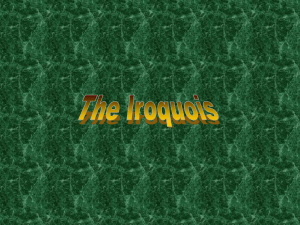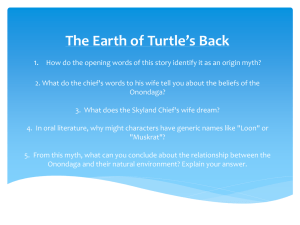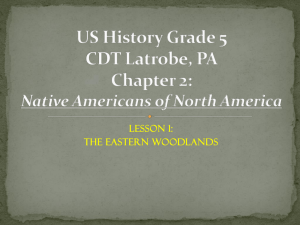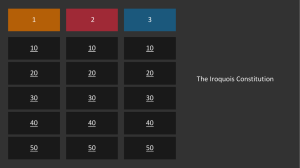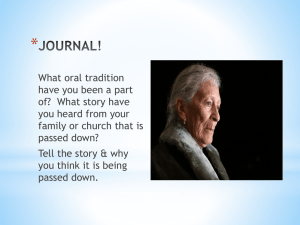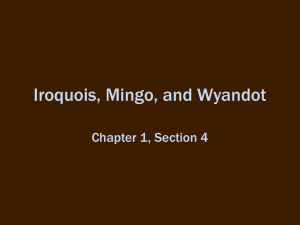File
advertisement
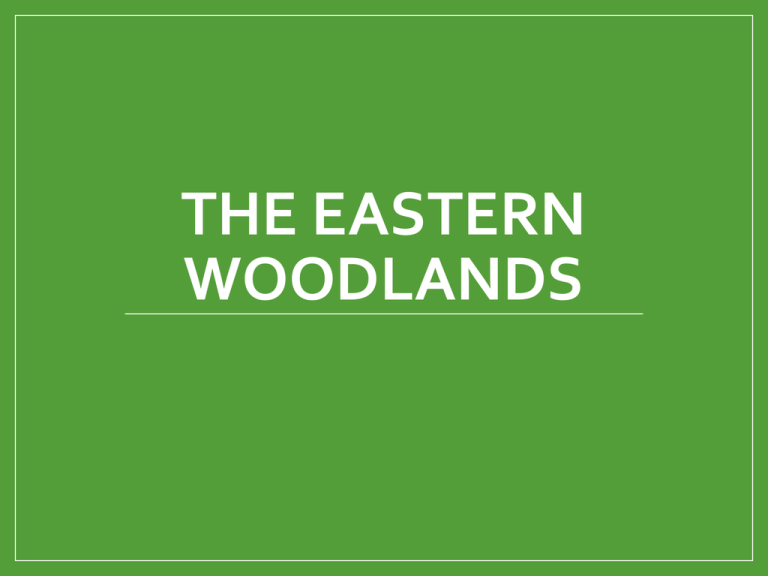
THE EASTERN WOODLANDS You Are There The campfire crackles and glows before you. An old man rises to tell a legend. Long ago, he begins, your people often went to war. The battles were bloody and cost many lives. But then a man named Deganawidah (day gahn uh WEE duh) had a vision. He told the warring groups to stop their endless battling. They should agree to deal fairly with one another and establish a lasting peace. The old man continues the legend by telling of Hiawatha (high uh WAH thuh), who convinced five warring groups to join together in a “Great Peace.” People of the five groups buried their weapons. Over these weapons Deganawidah planted a magnificent white pine called the “Tree of Peace.” The Iroquois • The legends about Deganawidah and Hiawatha are part of the early history told by the Iroquois (IR uh koy) people. The five groups were tribes of American Indians. • A tribe —a group of families bound together under a single leadership—is a term often used to describe people who share a common culture. • The five tribes were the Seneca, Cayuga, Onondaga, Oneida, and Mohawk. • Scholars think that in about 1580, these tribes came together to create the Iroquois League. A league is an organization that people form which unites them for a particular purpose. Later, a sixth tribe, the Tuscarora, joined the Iroquois league. The Iroquois • The five tribes sent 50 representatives—all men— to a Great Council. This council made decisions for the League as a whole. • The older women of the tribes chose—and could remove—these representatives. http://www.thecanadianencyclopedia.com/media/iroquois-council-discussions-753.jpg The Iroquois • The Iroquois Trail linked the lands of the League. Find it on the map below. Today, the New York Thruway follows part of the route of the Iroquois Trail. • The Iroquois lived in the Eastern Woodlands cultural region of North America. It is just one of several regions that you will study in this chapter. • Native American tribes within each of these regions developed similar cultures, using the resources of their environments. Each different one is a cultural region —an area in which people with similar cultures live. Living in the Woodlands • The Eastern Woodlands region provided rich resources for the Iroquois and other woodland people. • Thick forests offered nearly endless supplies of wood. • People hunted animals that were plentiful in the area—such as deer, bear, elk, and beaver—for food. They used the skins and furs of these animals for clothing. Living in the Woodlands Thousands of lakes, rivers, and streams provided water and fish. Native Americans grew such crops as corn, beans, and squash in the fertile soil. Living in the Woodlands • Look at the diagram on this page. It shows a longhouse, an Iroquois building used for shelter. Young trees provided poles for the frame, and slabs of elm bark served as walls. • You may be wondering why it was called a longhouse. It could be as long as 150 feet, half of a football field. • Each longhouse was divided into living areas for as many as 12 different families. Rows of shared cooking fires were placed in a center aisle of the longhouse. An Iroquois village or town could have as many as 150 longhouses. Living in the Woodlands The Iroquois called themselves the Haudenosaunee (hoo dee noh SHAW nee), which means "People of the Longhouse." The name Iroquois originally came from other tribes, speakers of the Algonquian (al GONG kwee in) language. Algonquian speakers included the Wampanoag, Powhatan, and Pequot. Living in the Woodlands The Iroquois also used trees to make their swift birch-bark canoes. They bent birch saplings to make the frame. They then stretched wide strips of bark over the frame. First they used sharp, pointed tools called bone awls to punch holes in the bark. Then they used bone needles to sew the pieces together. Finally, they covered the seams with tree gum to make the canoes watertight. Living in the Woodlands • The Iroquois used the woodlands for both food and clothing. For example, men hunted for deer. They used the animal hides for clothing and the meat for food. Women tanned the hides and sewed them into shirts and leggings. • They also cleared parts of the woodlands of trees to make fields for crops. • In spring, they attached birchbark containers to the maple trees and gathered the sap for maple syrup Iroquois Beliefs and Customs • Like other Native Americans, the Iroquois felt a deep connection to the animals, the trees, and other resources around them. When an Iroquois hunter killed a deer, he knelt beside it and spoke to it. He thanked it for the food and clothing it would provide for his family. Only then did the hunter take out his skinning knife. • At harvest time, the Iroquois gave thanks for their crops. Iroquois Beliefs and Customs • The photograph on this page shows wampum, polished seashells that were hung on strings or woven into belts. Wampum was highly valued by the Iroquois. A wampum belt might serve as a gift to honor a marriage. It might be given to comfort someone after the death of a loved one. Some belts were created to symbolize an important event. Wampum could even be used as an invitation to peaceful talks. The Iroquois Today • There are about 50,000 Iroquois today. Many live on reservations —land set aside by the United States government for Native Americans—in northern New York state. Fifty members still form its Great Council. They meet a few miles south of Syracuse, New York, on the Onondaga reservation. • League members, mainly from the Mohawk tribe, have become skilled builders of city skyscrapers. They are known as high iron men, putting up girders as high as a thousand feet above the ground Review 1. How did the Iroquois League make decisions? 2. How did the tribes of the Eastern Woodlands use natural resources to support themselves? 3. Explain the point of view of Deganawidah and Hiawatha about cooperation among the five tribes. 4. Where do the Iroquois live today 5. Suppose you are an Iroquois representative at the Great Council. Write about the different problems that might arise among the tribes. What are your ideas to solve the problems?
